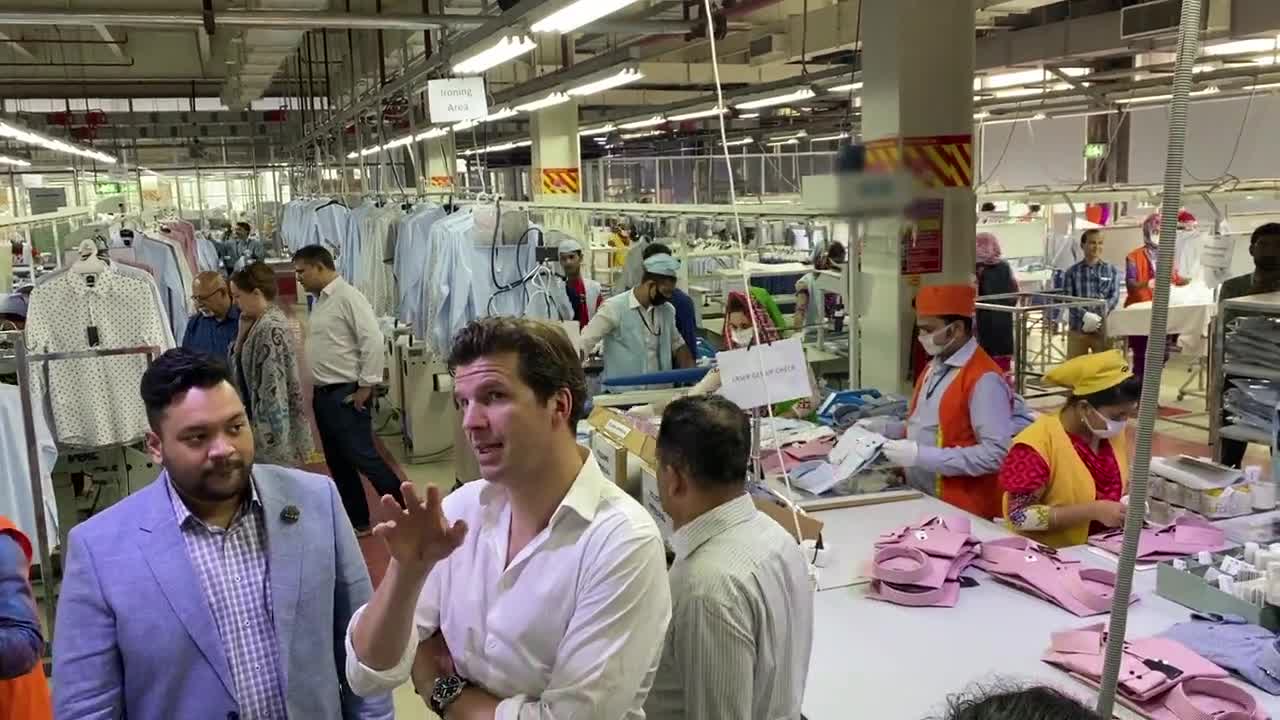In late 2019 Investment Managers Alan Lander and Des Armstrong travelled to Vietnam and Bangladesh to examine standards and practices in factories contracted by global brands and retailers to manufacture apparel and footwear. In order to assess standards, evident failings, opportunities and hurdles, the itinerary included meetings with factory owners, trade unions, industry organisations and NGOs. For Alan, this was a chance to gauge progress, having undertaken a similar trip to Bangladesh and Myanmar in 2014. His conclusions were unfortunately mixed. For Des, a 15-year veteran of the Investment team, “this was the best research trip of my career. It was also the most arduous, physically and emotionally”.
Any global apparel or footwear brand or retailer worth their salt will recognise the importance of robust standards and practices across the supply chain. The reputational and financial risk of failure, environmentally or socially, along the supply chain is certainly recognised today. Just as importantly, the long-term economic value that comes from adherence to sound ESG principles and practices is now widely accepted. For those reasons, how a company ensures the necessary and appropriate oversight of its supply chain, including outsourced third parties, is an important area of conversation for us as we engage with company management. But, to fill the gap between the high-profile disasters that we read about in the media and what company management teams might present as their path, or what glossy corporate websites might proclaim, we need to understand where particular challenges lie.
We need to have some understanding of the reality on the ground. We need to build our own knowledge and gather our own impressions to assess what company management might tell us. That knowledge also helps us judge company targets. Are they appropriate and, realistically, ambitious? What do those targets tell us about a company’s actual commitment to these issues and, in turn, what might they tell us about a corporate culture? To answer all these questions, this type of trip is a very important part of our integrated approach to ESG research.
Vietnam has benefited from a powerful combination of a supportive state approach to foreign investment, cheap labour and an organised system of labour governance.
The global supply chains carefully engineered by so many high-street retailers and high-profile apparel brands will very often span numerous countries, sometimes across multiple continents. But developing markets are where focus, and risk, so often falls and so those markets were our starting point in planning this trip. Having undertaken a similar trip in 2014 to Bangladesh and Myanmar, it made sense to revisit Bangladesh to see first-hand how things might have changed, for the good, or otherwise. Myanmar, which was in 2014 thought to be on the cusp of growth, has not in fact followed that anticipated path and so Vietnam was chosen as an appropriate comparison. In Vietnam, this area of the manufacturing sector is newer but growing faster. By visiting both countries, we hoped to better understand their respective positions and recent success.
Both Vietnam and Bangladesh have been net beneficiaries of China’s overarching desire to transition the economy to high value-add manufacturing. More recently, US-China trade tensions have added momentum to that trend, again to the benefit of both countries.
According to World Trade Organisation figures on global apparel exports, China remains the dominant player but less so than it was. From 2015 to 2018, China’s percentage share fell from 39.3% to 31.3% with Bangladesh’s share rising from 5.9% to 6.4%, albeit outpaced by Vietnam whose share rose from 4.8% to 6.2%.
Vietnam has benefited from a powerful combination of a supportive state approach to foreign investment, cheap labour and an organised system of labour governance. It has become an increasingly attractive sourcing destination for global brands.
In contrast, Bangladesh has arguably failed to capitalise on the situation as much as it should. Whilst labour costs are amongst the lowest in the world, it appears to have failed to establish the same level of trust necessary to justify a step-up in commitment to the industry. Furthermore, whereas Vietnam has successfully developed a reputation for increasing technical skills, more complex designs and the ability to work with man-made fibres, the industry in Bangladesh has very much stuck to cotton garments.
Whilst conditions are perhaps not what the ultimate shopper on Main Street might expect when they purchase the items being made in a Vietnam factory, the working conditions in the facilities we visited were certainly reasonable
Unlike our more usual research trip, the agenda was not packed with meetings with investee companies or possible investment candidates. Instead, the agenda was designed to allow us to better understand the third-party supply chain that supports some of our investments in apparel and footwear, both retailers and brands. These companies manufacture very little themselves, instead their fulfilment cycles rely on third-party suppliers located around the world.
Over the course of six days, we had 30 meetings with a variety of different stakeholders. We met with government bodies and NGOs involved in the industry, the local sourcing and compliance teams from a number of global brands, industry associations representing the manufacturers, as well as undertaking a number of factory visits where we met with owners, management and the factory workers themselves.
VIETNAM
Our journey began in Vietnam. In the capital Hanoi, we met with a number of relevant organisations including the Vietnam General Confederation of Labour, the state-run trade union. We then travelled to the industrial centre of south Vietnam, Ho Chi Minh City, to visit factories and speak to both owners and workers as well as brand representatives.
Whilst conditions are perhaps not what the ultimate shopper on Main Street might expect when they purchase the items being made in a Vietnam factory, the working conditions in the facilities we visited were certainly reasonable. We saw evidence of recent investment in machinery and factory buildings, reducing noise and improving air quality. Conversations with workers were reassuring. Whilst not ruling out work in a garment factory, one worker talked of her hopes that her daughter would have choices when it came to her working life, thanks to the income she receives from her job in the factory.
From the conversations across our range of meetings, it certainly appeared that the average factory worker is able to earn a living wage through a combination of minimum wage plus overtime in the context of a working environment that is largely acceptable. This felt to us like a sustainable situation. We left Vietnam reassured but with some apprehension as to how Bangladesh might compare.
BANGLADESH
In Bangladesh, getting from A to B is difficult and the infrastructure is, largely, terrible. It is all the things you might hear or read about. Monumental traffic jams, open sewers and inadequate roads are commonplace. Being there and travelling between factories brought home to us the impact that has on day-to-day life. Once we reached the factories that we were visiting, things were a little more positive.
A myriad of audits have shown that garment factories in Bangladesh are much safer places to work than they were back in 2013 when the Rana Plaza complex collapsed, killing more than 1,100 workers and injuring more than 2,500. That was certainly also our impression. The collapsed building housed a number of garment factories which were found to supply dozens of global clothing brands. In the publicity that followed, there was unprecedented industry collaboration to address building structure and safety. Two organisations: the Accord, which represented predominantly European companies and the Alliance, which was predominately US-related, were established by global apparel brands and retailers. Both were charged with overseeing a comprehensive programme of inspection and remediation of all factories in the supply chain.
As compared to our trip five years ago, as we toured factories this time, fire doors were certainly evident, unblocked and clearly marked. Sprinkler systems were also in place. In that sense, the unprecedented industry collaboration has made an important difference.
The conversations with workers in their slum city were not easy. It was to see first-hand the harsh reality of their lives. The factories are now much safer, but pay has not kept pace with inflation
However, as might be expected, this cannot be billed as an absolute success story. The Accord and the Alliance, we learnt, were not well received by the Bangladeshi manufacturing industry. It was seen as a colonialist approach to fixing the issue – “international brands telling Bangladeshi factories how to run their businesses” – without due regard for local laws and standards. This feeling was compounded by the fact that neither the Accord nor the Alliance had significant representation from the industry in their governance structures, nor did factory owners feel like they had been compensated for the costly investments that were made to comply with those internationally imposed standards. Today, more encouragingly, both the Accord and the Alliance are attempting to transition to local bodies with more input from the industry. That transition is, however, fraught with conflict. Will a local body, with industry representation, be as progressive when it comes to driving change?
That picture of improvement was also not matched when considering the life of factory employees. In one factory, we visited the on-site creche. This was a nursery with very few toys, little noise and very small children sat disconcertingly, in terms of our own experience at home, still on the floor. Of course, to have a creche at all is something to be applauded but it was a reminder that looking at a list of employee services or building facilities doesn’t always tell the full story.
Much more tellingly, we visited the homes of some female factory workers in the slums that tend to neighbour factories. In speaking to several workers in one home, effectively one room, there was a child present, aged around five or six. We asked where that child went during the day and the answer was that she just stayed in this room, in a slum with the equivalent box-like homes of around 50,000 people. In that context, the creche that we saw certainly didn’t compare to any other nursery we had ever seen, but it was for those children, and their parents, a safe and clean environment. And of course, we aren’t in a position to say if life would be far more challenging outside these urban areas.
The conversations with workers in their slum city were not easy. It was to see first-hand the harsh reality of their lives. The factories are now much safer, but pay has not kept pace with inflation. The workers that we met talked of back-dated rent rises for their shack-like accommodation and increased food prices the moment any wage rise was granted. The hope and aspiration that we had heard and sensed back in 2014 was no longer evident. Back then, in similar conversations with workers, there was certainly a sense of their factory job leading somewhere. The income that they received was a means to an improved standard of living. Of course, we only spoke to a small number of workers and there is danger in extrapolating on that small sample, but neither of us were left with an impression of hope on this trip.
ENGAGEMENT
Where does this tale of two countries take us in terms of our research, and company engagement? We didn’t expect perfect scores and it is always going to be the case that multiple stakeholders could be doing more. But, for the international apparel brands and retailers that we research and regularly engage with, current sourcing strategies reflect our findings. By way of example, Bangladesh is no longer a strategic sourcing country for Nike or Adidas. Bangladesh is, for example, still amongst Inditex’s sourcing destinations. However, the company did play an important and positive role within the Accord, and has stated its commitment to continued support of that work. We will continue to quiz company management on the practical outcomes of this work.
When we speak to companies, we are often told about ongoing audits to assess conditions and ensure that factories are meeting the standards laid down by these global corporations. Clearly, these audits are a good thing, but they are not guarantees. We met with a representative of one European retailer who was responsible for the oversight of third-party factories across South-East Asia. He acknowledged the challenge he faced, covering quite so much ground, and with very believable pragmatism, admitted that only 70% of the factories used by this retailer meet the required standards.
The knowledge and impressions gained on this trip will be fed into our questions to management teams on their sourcing strategies across developing markets.
Audits also lend themselves to checking environmental factors far more than social issues. Fair pay and reasonable treatment of workers are nebulous concepts as compared to installation of a sprinkler system, for instance. There first needs to be consensus on objectives in order to make an assessment. That assessment then requires time and effort. Issues like forced overtime or workplace harassment are much harder for an auditor to uncover when visiting a factory for just a few hours.
There is also the ever-present question of who should assume the cost of this important work. As one Bangladeshi factory owner told us, “they are just cleverer than we are”. He described the situation, in which the sales team from a particular retailer will come and negotiate terms and costs of a particular order. That retailer’s compliance team will arrive later and add all sorts of additional requirements and conditions in order to secure that particular order or contract. Any attempts to go back to the sales team to share the cost of those additional conditions are futile.
Responsibility must also lie at a state level. The growth in this sector in Vietnam, and the standards that we saw, has in a large part come thanks to its state support. Vietnam’s socialist system includes a strong and effective labour code giving rights to factory workers. These protections have been matched by successful efforts by the government to encourage investment and create an attractive sourcing destination for global companies.
In that sense the Bangadelshi government must assume some responsibility for its lack of recent success. The garment industry is critical to the Bangladeshi economy, accounting for the vast majority of its exports. Unfortunately, that significance also means that the industry, and factory owners, are deeply intertwined with politics. In that backdrop, it is difficult for the voices of workers to cut through. The state should have an important role to play in driving better governance. It is far more complex than pressuring well-known retailers to pay more for the garments it is procuring from Bangladesh. There is no guarantee that would translate into better pay for workers, especially on an inflation-adjusted basis. Historically, the industry has proven itself incapable of anything but a competitive race to the bottom on pricing.
For our part, in engaging with companies, we can continue to ask about initiatives that might directly improve the standard of living for workers, such as subsidised groceries, healthcare programmes, child-care benefits or occupational insurance plans to name but a few.
Development of trade unionism could be an answer. Freedom of association is still a right that many workers find elusive. Anecdotally, we visited one factory in Bangladesh where recent unrest about wages had resulted in a number of workers ‘resigning voluntarily’. Just as importantly, the unrest had resulted in customers pulling orders from the factory, heaping more financial pressure onto the business.
WHAT NEXT?
We will certainly return to this region to visit factories and continue the conversation with many of the groups that we met. Audits have become standard practice, and thereby are often the starting point when we engage with global companies. The archetypical clipboard and tick-box sheet of course has its place, but it is so much more than that. Environmental and social standards in these factories matter to society, matter to consumers and matter to the bottom line of companies in which we invest.
We cannot visit every factory, nor can a trip like this ever give a truly comprehensive view. But the knowledge and impressions gained on this trip will be fed into our questions to management teams on their sourcing strategies across developing markets, oversight of factories in those markets and the conditions for the workers within those factories. We are also much better placed to interpret and judge the responses from retailers and apparel brands. Judging reality from rhetoric. Separating proactive steps from mere PR.
Important Information
This article is provided for general information only and should not be construed as investment advice or a recommendation. This information does not represent and must not be construed as an offer or a solicitation of an offer to buy or sell securities, commodities and/or any other financial instruments or products. This document may not be used for the purpose of an offer or solicitation in any jurisdiction or in any circumstances in which such an offer or solicitation is unlawful or not authorised.
Stock Examples
The information provided in this article relating to stock examples should not be considered a recommendation to buy or sell any particular security. Any examples discussed are given in the context of the theme being explored.




